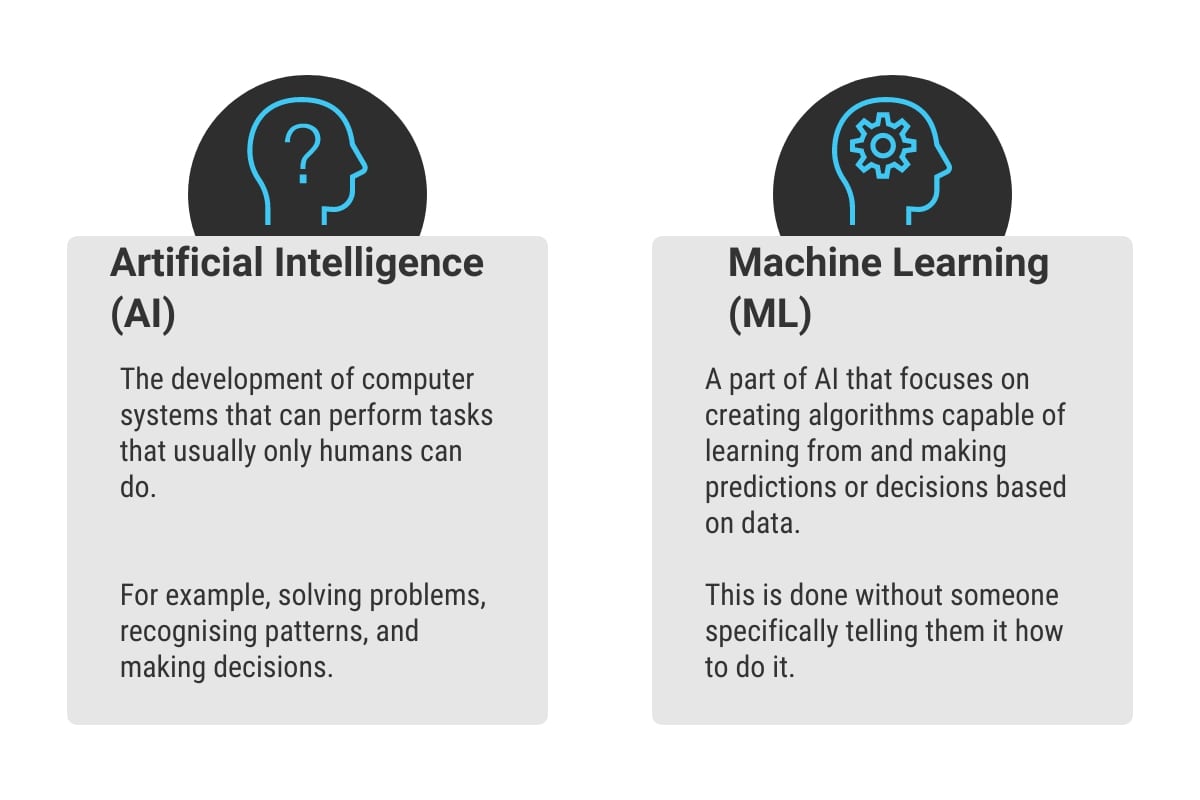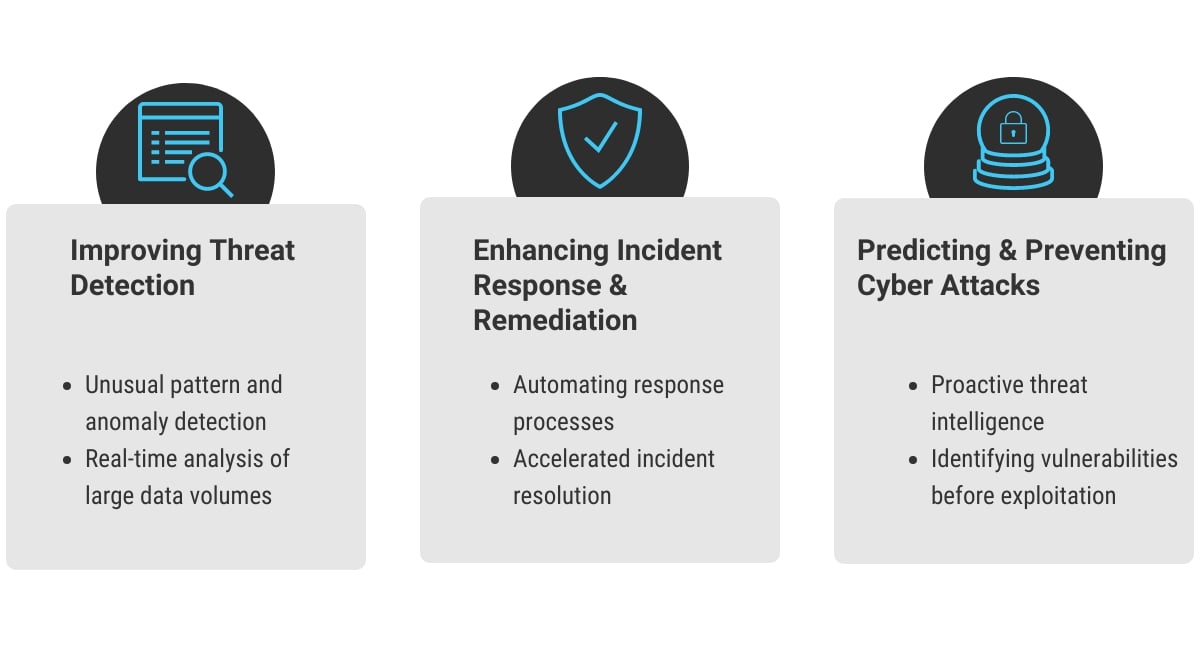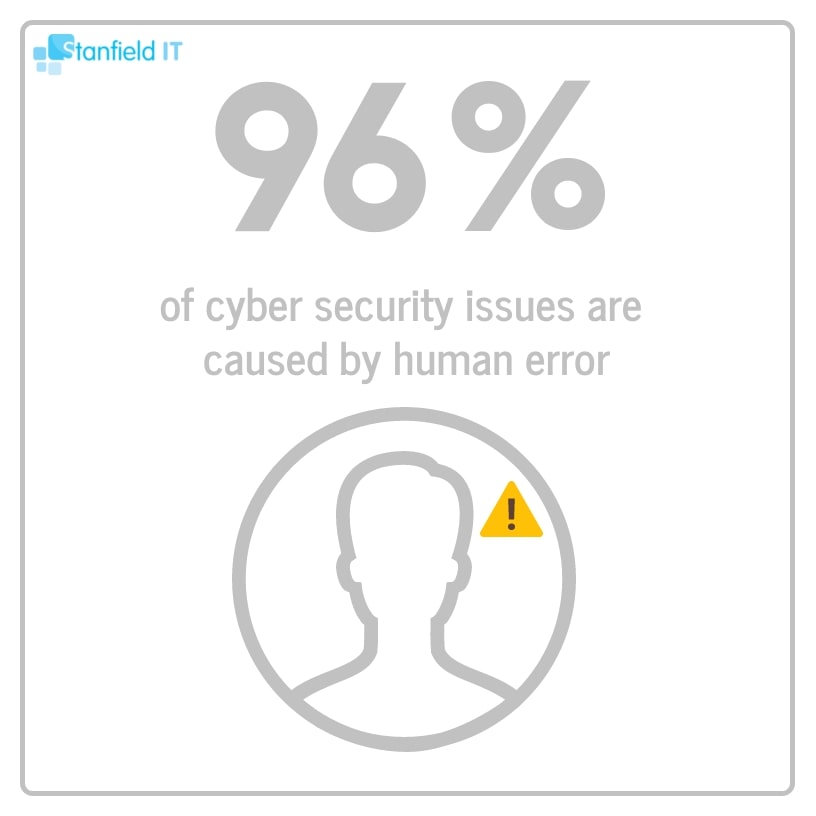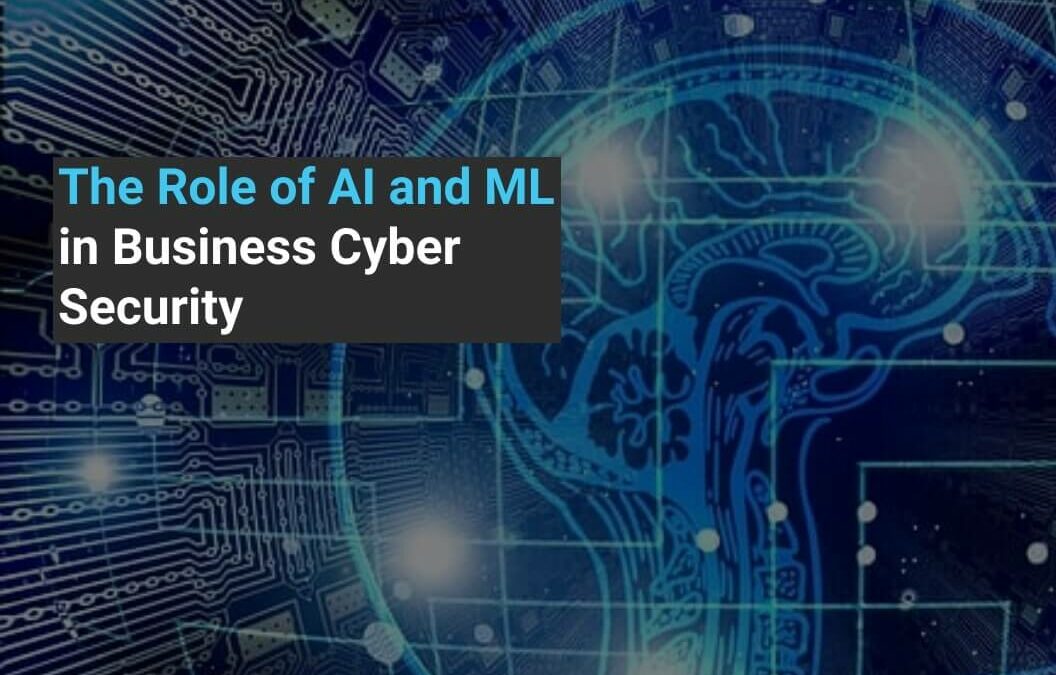Artificial intelligence (AI) and machine learning (ML) are rapidly advancing technologies. And each has made significant strides in various industries, including cyber security.
The cyber security landscape has become increasingly complex and challenging. Criminals are constantly evolving their tactics and exploiting new vulnerabilities. As a result, traditional security measures are struggling to keep pace with the rapidly changing threat environment.
This is where AI and ML come in. They offer businesses the potential to revolutionise their cyber security and detect, prevent, and respond to threats more effectively.
In this article, we’ll explain AI and ML technologies and how they are shaping the future of cyber security. We’ll also explain how your business can leverage these technologies to improve its cyber security posture.
By understanding the role these technologies play in cyber security, your organisation can make informed decisions about their adoption and integration into existing security strategies.
Get Your Free Essential Eight Cyber Security Report
Learn:
-
- The cyber security gaps costing you time and money.
- Practical steps to upgrade your security measures.
- The hidden risks of poor security protocols.
- How to bolster your cyber security and aid business growth.
What is AI and ML?
AI refers to the development of computer systems that can perform tasks that typically require human intelligence. For example, problem-solving, pattern recognition, and decision-making.
Machine learning is a subset of AI. It involves the creation of algorithms that can learn from and make predictions or decisions based on data. It can do so without being explicitly programmed to do so.

Let’s break that down in simpler terms. Imagine AI is a super smart computer program that can do things people usually do; like solve problems and understand patterns. It’s like having a digital assistant that can learn new tasks and become smarter over time. Just like a human would.
Now, machine learning is a part of AI that helps this digital assistant learn and improve. Instead of someone telling the assistant exactly what to do, ML allows it to figure things out on its own by looking at lots of examples.
For example, let’s say we show the digital assistant thousands of pictures of cats and dogs. It can learn to tell them apart without being explicitly told how to do it. So, the more data the digital assistant sees and learns from, the better it gets at making decisions or predictions based on that data.
In the context of cyber security, AI and ML can help protect computers and networks by learning to identify harmful activities or potential threats.
Instead of a digital assistant, think of it as a digital detective that gets smarter and better at its job over time.

How AI and ML are Transforming Cyber Security

Improving Threat Detection
AI and ML technologies have been game changers in threat detection by enabling security systems to:
Identify unusual patterns and anomalies
By analysing vast amounts of data, AI and ML algorithms can recognise patterns that deviate from normal behaviour. This allows them to identify potential cyber attacks or unauthorised access.
This can help security teams pinpoint threats that might have otherwise gone undetected. They can then act swiftly and minimise damage.
Real-time analysis of large volumes of data
Traditional security systems are often overwhelmed by the sheer volume of data generated by modern networks and devices. AL and ML-powered systems can process this data in real time. Allowing them to identify potential threats and alert security teams instantly.
This allows businesses to stay ahead of cybercriminals and prevent attacks from escalating.
Enhancing incident response and remediation
AL and ML technologies also play a critical role in improving response and remediation efforts by:
Automating response processes
You can program AI and ML algorithms to automatically take a specific action in response to detected threats. For example, isolating affected devices, blocking malicious IP addresses, or notifying appropriate personnel.
This will reduce the time it takes to respond to an attack and reduce further damage.
This leads us to…
Accelerated incident resolution
AI and ML can analyse the root causes of security incidents more efficiently than a human can. This makes it easier to identify and address underlying vulnerabilities.
So you’ll get faster resolution of incidents and a reduced risk of future attacks stemming from the same vulnerability.
Predicting and preventing cyber attacks
One of the most promising applications for AL and ML in cyber security is their ability to predict and prevent cyber attacks before they occur. They achieve this by:
Proactive threat intelligence
AI and ML systems can collect and analyse data to identify emerging threats, trends, and attack patterns.
This helps security teams stay informed about potential risks and take measures to defend against them before they materialise.
Identifying vulnerabilities before they’re exploited
AI and ML technologies can scan networks, devices, and applications for known and unknown vulnerabilities. This makes it easier to patch them before cybercriminals can exploit them.
This proactive approach to vulnerability management will help your organisation maintain a robust security posture and reduce the likelihood of successful cyber attacks.
The Benefits of AI and ML for Business Cyber Security
AI and ML technologies offer numerous advantages for businesses when it comes to enhancing theory cyber security efforts.
Some key benefits include:
A. Improved efficiency and reduced workload for security teams
AI and ML can automate many routine tasks that security professionals would otherwise perform manually.
By handling tasks like monitoring logs, scanning for vulnerabilities, and analysing network traffic, these technologies can significantly reduce the workload on security teams.
This allows security teams to focus on more strategic and complex issues.
B. Reduced risk of human error
Human error is one of the most common causes of security breaches. AI and ML can help minimise this risk by automating various security processes.
This will reduce the likelihood of mistakes stemming from human intervention.
Furthermore, these technologies can continually analyse and learn from past errors, further refining their detection and response capabilities.

C. Enhanced threat visibility and monitoring
AI and ML algorithms can process large amounts of data at high speeds, providing businesses with unprecedented visibility into their networks and systems.
This enhanced monitoring capability enables organisations to detect potential threats and anomalies that might have otherwise gone unnoticed.
Ultimately, this will strengthen the overall security posture of businesses.
D. Faster response to emerging threats
One of the key advantages of AI and ML in cyber security is their ability to rapidly adapt to new threats and attack vectors.
By continuously learning from the evolving threat landscape, these technologies can help your business respond faster to emerging threats.
This minimises the potential impact of cyber attacks and reduces the window of opportunity for cybercriminals to exploit vulnerabilities.
Challenges and Limitations
Despite the numerous benefits, there are limitations to the use of AI and ML in cyber security. It’s important to consider the following challenges.
Data quality and biases
These algorithms rely heavily on the quality of the data they are trained on.
If the input data is biased or incomplete, the technology may generate inaccurate or biased results. This could negatively impact their ability to detect and respond to threats.
It is therefore crucial to ensure the quality and diversity of training data for developing effective AI and ML-based security systems.
Adversarial attacks targeting AI/ML systems
Just like we look for ways to use AI and ML systems to benefit us, cybercriminals are looking for ways to exploit the technology for themselves.
One such example is adversarial attacks, where attackers manipulate data to deceive AI/ML algorithms. This forces them to produce incorrect results.
Security teams must understand these potential threats and design AI/ML systems with robust defences against such attacks.

Over-reliance on automation
AI and ML can automate many aspects of cyber security. However, it’s important not to become over-reliant on these technologies.
Human expertise and judgement remain crucial in certain situations, especially when confronting complex or new threats.
Your business should always strike a balance between automation and human intervention. Doing so will ensure a comprehensive and effective security strategy.
Legal and ethical considerations
The use of AI and ML in cyber security raises several legal and ethical questions, such as:
-
- Data privacy
- Algorithmic transparency
- Accountability
Organisations must navigate these concerns while adhering to applicable laws and regulations, such as the Australian Privacy Act 1988, General Data Protection Regulation (GDPR) and other data protection laws.
Additionally, your business should carefully consider the ethical implications of its AI/ML systems. Be sure to implement them in a manner that respects user privacy and promotes fairness and transparency.
How to Leverage AI and ML in Your Business
To harness the power of AI and ML technologies in your cyber security efforts, your business can follow these practical tips:
Adopting AI/ML-powered security tools and platforms
Firstly, your business should consider in investing in AI/ML-driven security solutions that meet its specific needs and requirements.
There are numerous tools and platforms available in the market, ranging from threat detection and response systems to vulnerability management solutions.
Conduct thorough research and evaluate the available options before choosing the most suitable solution for your organisation.
Collaborating with trusted vendors and MSPs
Working with experienced vendors and Managed Service Providers (MSPs) can help your business implement AI and ML technologies effectively.
These partners can provide you with valuable expertise, support, and resources. This will help ensure the successful deployment and management of AI/ML-driven security solutions.
Training & upskilling security teams
The success of AI and ML technologies in cyber security relies heavily on the expertise of the human counterparts who work with them.
Your organisation should invest in ongoing training and upskilling of its security teams.
This will ensure that they are well-equipped to manage AI/ML systems and respond to the evolving threat landscape.
Integrating AI/ML into existing security processes
Finally, implementing AI and ML technologies in isolation is unlikely to bring effective results.
Instead, your business should strive to integrate these advanced capabilities into its existing security processes and infrastructure.
This may involve updating policies, procedures, and workflows to accommodate AI/ML-driven insights and decision making.
Additionally, it will foster a culture of collaboration between human experts and AI/ML systems.
AI in Action – Tools You Can Use
Microsoft Defender for Endpoint
Microsoft Defender for Endpoint uses AI and machine learning to provide businesses with enhanced cybersecurity protection in the following ways:
1. Predicting risk: The system assesses the risk level of each device using machine learning algorithms, considering factors like previous malware encounters and suspicious behaviours.
2. Personalised protection: The AI-driven system adapts protection levels in real time based on the device’s risk score, offering a tailored security experience for each device.
3. Adjusting defences: If a device is at high risk, the system increases its defence aggressiveness to prevent potential threats. Once the risk is reduced, the system returns to normal defence levels, minimising disruption to daily operations.
4. Blocking malicious use of legitimate tools: The system can detect when attackers use legitimate processes or files in a harmful manner, blocking these activities on high-risk devices.
5. Stopping advanced threats: The AI-powered system is capable of detecting and blocking advanced threats like ransomware loaders, which may evade traditional detection methods.
6. Preventing ransomware attacks: Even if early-stage attack activities go unnoticed, the system can block the final stage of a ransomware attack, preventing data encryption and ransom demands.
For business owners, Microsoft Defender for Endpoint offers a more intelligent, adaptive, and personalized security solution that proactively defends devices and networks against evolving cyber threats, minimizing the risk of data breaches and disruptions.
Microsoft Security Copilot
Microsoft recently introduced a new AI-powered security analysis tool called Microsoft Security Copilot. This innovative solution is built upon OpenAI’s GPT-4 model. It leverages the vast amount of telemetry data from Microsoft’s enterprise deployments and Windows endpoints.
Security Copilot aims to automate incident response and threat hunting tasks, enhancing the capabilities of security teams. It simplifies threat intelligence by summarising and correlating threat activities. This enabled security teams to make informed decisions rapidly.
The chatbot works hand-in-hand with security teams, allowing them to better understand their environment, learn from existing intelligence, and catch what others might miss.
For incident response teams, the chatbot can identify ongoing attacks, assess their scale, and provide remediation instructions based on proven tactics from real-world security incidents.
Threat hunting practitioners can also benefit from Security Copilot, as it can determine susceptibility to known vulnerabilities and exploits.
Furthermore, the tool can generate customisable reports summarising events, incidents, or threats in a matter of minutes.
Microsoft Security Copilot easily integrates with Microsoft Sentinel, Microsoft Defender, and Microsoft Intune, offering a comprehensive security program experience.
We have a more in-depth article about Security Copilot here.
Conclusion
As cyber threats continue to evolve in complexity and sophistication, the potential of AI and ML to improve cyber security is increasingly apparent.
By enabling faster, more accurate threat detection and responses, as well as proactive defence measures, these technologies can significantly bolster the security posture of your business, helping you stay one step ahead of cybercriminals.
Considering the security advantages offered by AI and ML, businesses of all sizes should explore and adopt these technologies.
By investing in these tools, you can effectively harness the power of AI and ML to strengthen your security posture and better protect yourself against the ever-evolving threat landscape.
More Like This
Windows 10 End of Life (EOL) and What it Means
Microsoft has announced that October 14, 2025, will be the End of Life (EOL) date for Windows 10. Windows 10 EOL is set to affect all versions of Windows 10, including Home, Pro, Education, and Enterprise. Research from Lansweeper indicates that only 23.1% of...
ISO 27001 Certification in Australia: A Comprehensive Guide
Business data is like a treasure for cyber criminals. In fact, buried in almost every organisation's information assets are details worthy of holding ransom. So, how do you protect it? With ISO 27001 certification. ISO 270001 is more than just a standard industry...
Cyber Hygiene For Business: What You Need To Know
Implementing cyber hygiene practices is one of the most effective ways to protect your business from cybersecurity risks. As a business owner, the security of your company's data is paramount. With the prevalence of cyber-attacks in the modern world, it’s increasingly...



